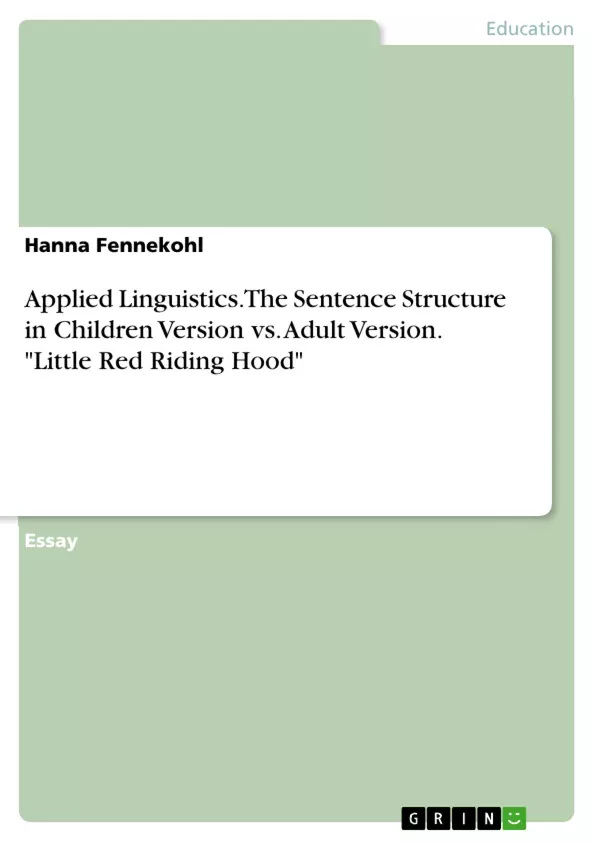“Once upon a time” there were only 100 languages in the world. Nowadays there are around 5,000 to 10,000 languages (Kracht 2011: 4). Every language has five levels of analysis: morphology, phonology, phonetics, semantics and syntax. Both the semantic and the morphology are closely related to the syntax. While the morphology deals with the structure within words, the semantic deals with the meaning of sentences and the syntax with the grammatical structure of sentences (Brown & Miller 1980: 12). Each language has its own unique structure. However, there are also differences within a language. The structure not only changed historically but also when it comes to the target groups. To make these differences clear, this essay will focus on the syntactic structure of children vs. adult fairy tales.
Table of Contents
- Introduction
- Syntactical Categories
- Sentences
- Clauses
- Phrases
- Word Classes
- How Children Are Introduced to the Written Language
- Little Red Riding Hood - Syntax Analysis
- Conclusion
Objectives and Key Themes
This essay aims to analyze the syntactic differences between children's and adult versions of fairy tales. It investigates how sentence structure varies across these versions and explores the implications of these variations for language acquisition and linguistic development.
- Syntactic differences between children's and adult fairy tales.
- The role of sentence structure in language acquisition.
- Analysis of sentence types (declarative, interrogative, imperative, exclamative).
- Comparison of simple, compound, and complex sentences.
- Examination of phrase structure and word classes.
Chapter Summaries
Introduction: This introductory section establishes the context of the essay by highlighting the vast number of languages globally and emphasizing the five levels of linguistic analysis: morphology, phonology, phonetics, semantics, and syntax. It underscores the interconnectedness of semantics and morphology with syntax and emphasizes the variations in sentence structure within and across languages, both historically and in relation to target audiences. The essay focuses on comparing the syntactic structure of children's and adult fairy tales to illustrate these variations.
Syntactical Categories: This chapter delves into the core concepts of syntax, defining it as the study of sentence construction and the rules governing the combination of lexical and grammatical elements into phrases, clauses, and sentences. It differentiates between major and minor sentences, outlining criteria for distinction such as substitution, transformation, and subject-predicate structure. The chapter then elaborates on the four major sentence types: declarative, interrogative, imperative, and exclamatory, providing examples of each. It also distinguishes between simple, compound, and complex sentences based on the number and types of clauses they contain.
Little Red Riding Hood - Syntax Analysis: This chapter would presumably provide a detailed comparative analysis of the syntax used in children's and adult versions of the Little Red Riding Hood story. It would likely dissect specific sentences, identify sentence types, analyze phrase structure, and examine the word classes utilized in each version, highlighting the differences in complexity and grammatical structures. This section would serve as the core of the essay, demonstrating the practical application of the syntactic concepts explored earlier.
Keywords
Syntax, sentence structure, children's literature, adult literature, fairy tales, Little Red Riding Hood, comparative linguistics, language acquisition, simple sentences, compound sentences, complex sentences, clauses, phrases, word classes, declarative, interrogative, imperative, exclamative.
Frequently Asked Questions: A Comprehensive Language Preview
What is the main focus of this language preview?
This preview offers a comprehensive overview of a text analyzing the syntactic differences between children's and adult versions of fairy tales, specifically focusing on "Little Red Riding Hood." It examines how sentence structure varies and the implications for language acquisition and linguistic development.
What topics are covered in the Table of Contents?
The Table of Contents includes an introduction, a section on syntactical categories (sentences, clauses, phrases, and word classes), a discussion on how children are introduced to written language, a syntactic analysis of "Little Red Riding Hood," and a conclusion.
What are the key objectives and themes of the analysis?
The primary goal is to analyze syntactic differences between children's and adult fairy tales. Key themes include the role of sentence structure in language acquisition, analysis of sentence types (declarative, interrogative, imperative, exclamative), comparison of simple, compound, and complex sentences, and examination of phrase structure and word classes.
What does the chapter on Syntactical Categories cover?
This chapter defines syntax, differentiating between major and minor sentences based on criteria like substitution, transformation, and subject-predicate structure. It details the four major sentence types (declarative, interrogative, imperative, exclamatory) and distinguishes between simple, compound, and complex sentences.
What is the role of the "Little Red Riding Hood - Syntax Analysis" chapter?
This chapter provides a comparative analysis of the syntax in children's and adult versions of "Little Red Riding Hood." It dissects sentences, identifies sentence types, analyzes phrase structure, and examines word classes to highlight differences in complexity and grammatical structures.
What keywords are associated with this analysis?
Keywords include: Syntax, sentence structure, children's literature, adult literature, fairy tales, Little Red Riding Hood, comparative linguistics, language acquisition, simple sentences, compound sentences, complex sentences, clauses, phrases, word classes, declarative, interrogative, imperative, exclamative.
What linguistic levels are mentioned in the introduction?
The introduction mentions five levels of linguistic analysis: morphology, phonology, phonetics, semantics, and syntax, emphasizing their interconnectedness, particularly between semantics and morphology with syntax.
What is the overall purpose of this preview?
The preview serves as a comprehensive summary, providing readers with a clear understanding of the text's structure, objectives, and key findings before engaging with the full content. It's designed for academic use, supporting structured and professional thematic analysis.
- Quote paper
- Hanna Fennekohl (Author), 2018, Applied Linguistics. The Sentence Structure in Children Version vs. Adult Version. "Little Red Riding Hood", Munich, GRIN Verlag, https://www.grin.com/document/460690



